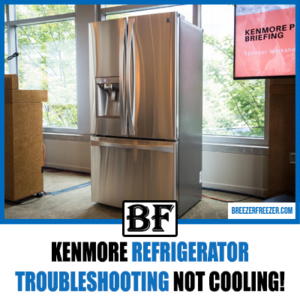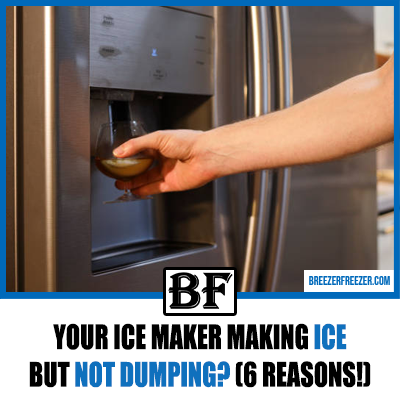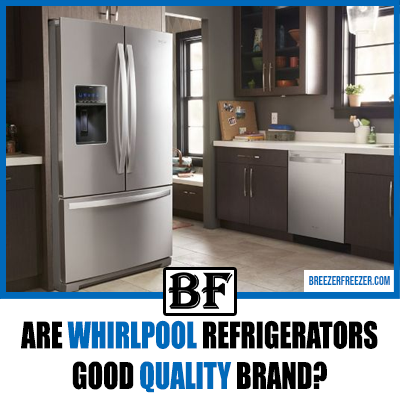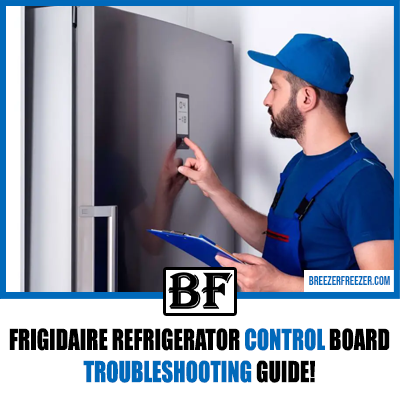Kenmore Refrigerator Troubleshooting Not Cooling! (10 Fixes!)
In essence, a non-cooling Kenmore refrigerator can be a major problem. However, there’s no need to give up on it just yet, as there are several troubleshooting steps you can take to fix the issue. This guide aims to provide solutions for a Kenmore refrigerator that is not cooling properly.

There are several potential reasons why a Kenmore refrigerator fails to cool. These include dirty condenser coils, overstuffing with food, a frosted evaporator fan, a leaky door, an obstructed or faulty condenser fan motor, or defects in components such as the thermostat, start capacitor, thermistor, compressor, temperature control board, or main control unit.
In the following sections, we will explore how these issues can hinder the cooling function of your Kenmore refrigerator and discuss the appropriate solutions. Additionally, we will address the scenario where a Kenmore fridge fails to cool but freezes, as well as the situation where it doesn’t cool immediately after a power outage. We will provide guidance on how to handle these events effectively.
Let’s get started!
Quick Troubleshooting
| Probable Cause | Fix |
| 1. Dirty/Dusty Condenser Coils | Use an effective condenser cleaning brush to clean the dirty/dusty condenser coils |
| 2. Food Overstuffing | Avoid overfilling the fridge to ensure proper air circulation |
| 3. Frosted Evaporator Fan | Test the evaporator fan with a multimeter and replace if it fails |
| 4. Leaky Door | Close the fridge door properly, and if the gasket is worn out or loose, replace it |
| 5. Obstructed or Faulty Condenser Fan Motor | Remove any obstructions around the condenser fan motor and replace if faulty |
| 6. Defective Temperature Control Thermostat | Replace the temperature control thermostat if it fails the multimeter continuity test |
| 7. Defective Start Capacitor | Replace the start capacitor if it fails the multimeter continuity test |
| 8. Faulty Thermistor | Test the thermistor with a multimeter and replace if it shows no continuity |
| 9. Faulty Compressor | Replace the compressor if it’s faulty |
| 10. Malfunctioning Temperature Control Board | Replace the temperature control board with the help of an expert |
| 11. Failed Main Control Board | Replace the main control board if no other parts are faulty |
Common Not Cooling Problems
If you’re experiencing issues with your Kenmore refrigerator not cooling, there are several factors to consider. Here are 11 possible reasons why your Kenmore refrigerator won’t cool and the corresponding solutions:
Dirty Condenser Coils
Over time, condenser coils can accumulate dirt and dust, hindering heat dissipation and affecting cooling efficiency.
Solution: Inspect the condenser coils and clean them using a flexible refrigerator coil cleaning brush.
Overstuffed Fridge
When the fridge is overloaded with food, it obstructs proper air circulation, preventing effective cooling.
Solution: Examine the food load and reduce it if the fridge is overfilled. Avoid stacking containers too closely together to enhance cold air circulation.
Frosted Evaporator Fan Motor
The evaporator fan motor, responsible for circulating air over the evaporator coils, can become frosted over time, hindering its cooling capacity.
Solution: Test the evaporator fan motor by hand rotation. If it doesn’t rotate or appears icy, use a multimeter to check for continuity. If there’s no continuity, replace the motor. If it rotates, defrost the motor to eliminate ice and adjust the fridge temperature.
Leaking Fridge Door
Improperly closed fridge doors or loose/worn-out door gaskets/seals can allow warm air in and cold air to leak out, hampering cooling performance.
Solution: Ensure the fridge door is properly closed and replace the door gasket if necessary.
Obstructed or Faulty Condenser Fan Motor
The condenser fan motor draws in air and circulates it around the fridge, aiding in cooling. If it’s obstructed, dirty, or faulty, it can impede the cooling process.
Solution: Inspect the condenser fan motor for obstructions or dirt and clear them if present. Use a multimeter to test the motor’s continuity. If it fails the test, replace the motor.
Malfunctioning Temperature Control Thermostat
The temperature control thermostat supplies voltage to the fan motors and compressor, crucial for cooling. Failure in any of these components results in inadequate cooling.
Solution: Test the temperature control thermostat with a multimeter and replace it if there’s no continuity.
Defective Start Capacitor
A faulty start relay can prevent the compressor from running, leading to inadequate cooling.
Solution: Use a multimeter to check the start relay for faults. If there’s no continuity, consider replacing it.
Faulty Thermistor
The thermistor monitors the fridge temperature and relays information to the main control board, enabling proper cooling. A defective thermistor disrupts this process.
Solution: Test the thermistor for continuity using a multimeter. If there’s no continuity, replace it.
Faulty Compressor
The compressor compresses and redistributes the refrigerant. A malfunctioning compressor can result in poor cooling.
Solution: Use a multimeter to test the compressor’s pin terminals. If there’s no continuity, the compressor is faulty and needs replacement.
Malfunctioning Temperature Control Board
The temperature control board, similar to the thermostat, supplies voltage to the fan motors and compressor. A faulty control board misdiagnoses voltage information, leading to cooling failure.
Solution: Have a professional inspect the temperature control board for faults and replace it if necessary.
Failed Main Control Board
If none of the above issues apply, the main control board might be responsible for the cooling unit’s failure, affecting various parts, including the ice maker and dispenser.
Solution: If multiple components, including the cooling unit, are not working, the main control board may be faulty and require replacement.
Troubleshooting Guide: Kenmore Refrigerator Not Cooling
If your Kenmore refrigerator is not cooling while the freezer is working fine, there are several possible reasons and solutions to consider:
- Faulty Evaporator Fan Motor: A defective evaporator fan motor can cause the fridge to fail without affecting the freezer. Test the motor using a multimeter and replace it if it’s faulty.
- Fridge Overload: If only the fridge is overloaded with food and not the freezer, it can hinder proper air circulation and cooling. Reduce the food load to create more space for cold air circulation.
- Excessive Frosting: If the refrigerator compartment is as cold as the freezer, frost can form over the evaporator coils, preventing proper cooling. Adjust the fridge temperature and allow the unit to defrost by unplugging it.
- Defective Defrost Component: A malfunctioning defrost timer, thermostat, or control board can prevent the fridge from cooling. Replace the faulty part to resolve the issue.
- Stuck Damper Control: If the damper control is stuck, it won’t allow cool air to stay in the refrigerator, resulting in inadequate cooling. Unstick the damper control if necessary.
- Door Leak: Ensure that the fridge door is closed properly and replace the door seal if it’s loose or broken. A door leak can affect the cooling performance of the unit.
Kenmore Refrigerator Not Cooling After Power Failure
If your Kenmore refrigerator is not cooling after a power failure, check if the circuit breaker has tripped. Fix the circuit breaker issue if necessary. You can also try resetting the fridge by following these steps:
- Identify the ultra-ice and home switches inside the fridge door and press them simultaneously.
- Hold the buttons for about 5 seconds until the controls turn off.
- Unplug the refrigerator for approximately 2 minutes, then plug it back in.
Kenmore Elite Refrigerator Not Cooling Error Code
If your Kenmore Elite refrigerator won’t cool and displays an error code after a power failure, there may be a burnt component. Inspect the temperature control thermostat, fans, and compressor as they are susceptible to electrical faults. Replace any faulty parts as needed.
Additional Questions
Why Isn’t My Kenmore Fridge Getting Cold?
Possible reasons for a Kenmore fridge not getting cold include filthy condenser coils, a stuffy refrigerator, an ice-covered evaporator fan motor, or faults in the thermostat, compressor, thermistor, or door seal.
Why Is My Fridge Running But Not Getting Cold?
If your fridge is running but not cooling, it may be due to dirty condenser coils, a faulty thermostat, start relay, or defrost timer, or a leaky door. The compressor, motor, or main control are less likely to be the issue.
Why Is My Kenmore Bottom Freezer Refrigerator Not Cooling?
A Kenmore bottom freezer refrigerator may not cool properly if the condenser coils are dusty, the evaporator coils are frosty, or the fridge is overloaded with food. Check the condition of the thermistor, start relay, start capacitor, and thermostats for any faults.
Why Is My Kenmore Refrigerator Not Cooling But Freezer Works?
If the freezer is working fine but the fridge is not cooling, potential causes include fridge overload, a leaky door, excessive frosting, a stuck damper control, or a defective defrost system.
Conclusion
When troubleshooting a Kenmore refrigerator that is not cooling, it is important to consider several factors. First, check for a potential leak in the fridge, dirty condenser coils, an overloaded fridge with food, or a frost-covered evaporator fan.
If none of these issues are present, it is likely that a component such as the thermistor, compressor temperature control thermostat, start relay, start capacitor, or main control is faulty. These components should be examined and replaced if necessary to resolve the cooling problem.





